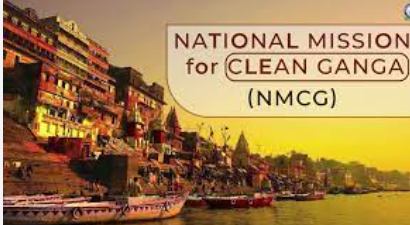National Mission for Clean Ganga
The National Mission for Clean Ganga (NMCG) is a flagship programme launched by the Government of India in June 2014 with the twin objectives of effective abatement of pollution and conservation and rejuvenation of the River Ganga. The mission is being implemented by the National Council for Rejuvenation, Protection, and Management of River Ganga (National Ganga Council), chaired by the Prime Minister of India.
Background
The River Ganga, considered sacred by millions of Indians, has been facing severe pollution and environmental degradation due to rapid urbanization, industrialization, and population growth along its banks. The government has been implementing various schemes and projects for the cleanup of the river since the mid-1980s, such as the Ganga Action Plan (GAP) and the National River Conservation Plan (NRCP). However, these efforts have had limited success in improving the water quality and ecological health of the river.
In 2014, the government launched the Namami Gange Programme, an integrated conservation mission with a budget outlay of Rs. 20,000 crore for five years, to address the challenges faced by the River Ganga in a comprehensive manner.
Objectives
The main objectives of the National Mission for Clean Ganga are:
- To ensure effective abatement of pollution and rejuvenation of the River Ganga by adopting a river basin approach to promote inter-sectoral coordination for comprehensive planning and management.
- To maintain minimum ecological flows in the River Ganga with the aim of ensuring water quality and environmentally sustainable development.
- To strengthen public participation and create awareness for the conservation of the River Ganga.
Key Initiatives
- Sewage Treatment Infrastructure: The NMCG has been focusing on the creation and rehabilitation of sewage treatment infrastructure in towns and cities along the River Ganga. As of March 2021, 156 sewage infrastructure projects have been sanctioned, out of which 75 have been completed and the remaining are at various stages of implementation.
- Industrial Effluent Monitoring: The mission has established a network of real-time water quality monitoring stations and labs to monitor industrial effluents and take necessary action against polluting industries. The Central Pollution Control Board (CPCB) has identified 764 Grossly Polluting Industries (GPIs) along the main stem of the River Ganga, out of which 704 have installed online continuous effluent monitoring systems (OCEMS).
- River Front Development: The NMCG has been implementing river front development projects in selected cities along the River Ganga to improve public access and amenities along the ghats, while also ensuring the conservation of cultural heritage and biodiversity.
- Afforestation: The mission has been promoting afforestation activities along the banks of the River Ganga to enhance the ecological health of the river and its tributaries. In 2019, the government launched a massive afforestation drive to plant over 200 million trees along the River Ganga.
- Biodiversity Conservation: The NMCG has been working towards the conservation of aquatic biodiversity in the River Ganga, including the conservation of the endangered Gangetic dolphin, which is the national aquatic animal of India. The mission has also been supporting the establishment of turtle conservation centers and the rescue and rehabilitation of turtles.
- Public Awareness: The mission has been conducting various public outreach and awareness programs to promote the conservation of the River Ganga and its ecosystem. These include the Ganga Quest, a national online quiz on the River Ganga, and the Ganga Utsav, an annual event to celebrate the cultural and spiritual significance of the river.
Challenges and Way Forward
Despite the concerted efforts of the NMCG and other stakeholders, the River Ganga continues to face significant challenges, including the discharge of untreated sewage and industrial effluents, solid waste dumping, and the loss of biodiversity. The COVID-19 pandemic has also impacted the progress of various projects and initiatives under the mission.
To address these challenges, the government has extended the Namami Gange Programme until 2026 with an additional budget outlay of Rs. 20,000 crore. The mission is also focusing on the development of a Ganga River Basin Management Plan (GRBMP) to ensure a comprehensive and integrated approach to the conservation and rejuvenation of the River Ganga.


